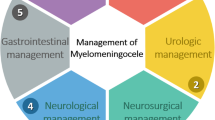Abstract
Purpose
In September 2020, the colorectal team of the International Center for Colorectal and Urogenital Care joined the spina bifida and spinal cord injury multidisciplinary clinic at Children’s Hospital Colorado. Many important lessons were learned.
Methods
A retrospective review of patients seen in the spina bifida and spinal cord injury multidisciplinary clinic from September 2020 to May 2021 was conducted. Data collected included demographics, diagnosis, pre or post-natal repair for those with myelomeningocele, whether the patient was previously seen by the colorectal team, wheelchair usage, voluntary bowel control vs. fecal incontinence, urinary control vs. clean intermittent catheterization, characteristics of contrast enema, and our proposed intervention.
Results
Overall, 189 children were seen during the study period, ranging from 3 months to 20 years of age (average = 9.5 years). One hundred and two were males and 87 were females. Diagnosis included myelomeningocele (n = 153), spinal cord injury (n = 18), transverse myelitis (n = 7), sacral agenesis (n = 5), diastematomyelia (n = 2), spinal stenosis (n = 2), and tethered cord with lipoma (n = 2). Fifteen patients with myelomeningocele were repaired in-utero. One hundred and sixty patients were new to the colorectal team. Eighty-one patients were wheelchair users. One hundred and twenty-three patients suffered from fecal incontinence and needed enemas to be artificially clean for stool and thirty-eight patients had voluntary bowel movements and were clean with laxatives, suppository, or rectal stimulations. Twenty-eight patients were younger than three years of age and still in diapers. Despite a non-dilated colon on contrast enema, this population has a hypomotile colon. One hundred and twenty-eight patients required clean intermittent catheterization.
Conclusion
Joining the spina bifida and spinal cord injury multidisciplinary clinic allowed us to better serve this population and gave us enormous satisfaction to contribute to improve the quality of life of the patients and their parents.
Level of evidence
III


Similar content being viewed by others
References
Choi EK, Shin SH, Im YJ, Kim MJ, Han SW (2013) The effects of transanal irrigation as a stepwise bowel management program on the quality of life of children with Spina bifida and their caregivers. Spinal Cord 51(5):384–388. https://doi.org/10.1038/sc.2013.8
Stevenson RE, Allen WP, Pai GS, Best R, Seaver LH, Dean J, Thompson S (2000) Decline in prevalence of neural tube defects in a high-risk region of the United States. Pediatrics 106(4):677–683. https://doi.org/10.1542/peds.106.4.677
Malone PS, Wheeler RA, Williams JE (1994) Continence in patients with spina bifida: long term results. Arch Dis Child 70(2):10710. https://doi.org/10.1136/adc.70.2.107
Burns AS, St-Germain D, Connolly M et al (2015) Phenomenological study of neurogenic bowel from the perspective of individuals living with spinal cord injury. Arch Phys Med Rehabil 96(1):49–55. https://doi.org/10.1016/j.apmr.2014.07.417
Anderson KD (2004) Targeting recovery: priorities of the spinal cord-injured population. J Neurotrauma 21(10):1371–1383. https://doi.org/10.1089/neu.2004.21.1371
Glickman S, Kamm MA (1996) Bowel dysfunction in spinal-cord-injury patients. Lancet 347(9016):1651–1653. https://doi.org/10.1016/s0140-6736(96)91487-7
Kirk PM, King RB, Temple R, Bourjaily J, Thomas P (1997) Long-term follow-up of bowel management after spinal cord injury. SCI Nurs 14(2):56–63
Stone JM, Nino-Murcia M, Wolfe VA, Perkash I (1990) Chronic gastrointestinal problems in spinal cord injury patients: a prospective analysis. Am J Gastroenterol 85(9):114–119
Choi EY, Im YJ, Han SW (2017) Bowel management and quality of life in children with spina bifida in South Korea. Gastroenterol Nurs 40(3):208–215
Johnsen V, Skattebu E, Aamot-Andersen A, Thyberg M (2009) Problematic aspects of faecal incontinence according to the experience of adults with spina bifida. J Rehabil Med 41(7):506–511. https://doi.org/10.1111/apa.12756
McClurg D, Norton C (2016) What is the best way to manage neurogenic bowel dysfunction? BMJ 354:3931. https://doi.org/10.1136/bmj.i3931
Ojetti V, Bruno G, Paolucci V, Triarico S, D’aversa F, Ausili E, Gasbarrini A, Rendeli C (2014) The prevalence of small intestinal bacterial overgrowth and methane production in patients with myelomeningocele and constipation. Spinal Cord 52(1):61–64
Wide P, Mattsson GG, Drott P, Mattsson S (2014) Independence does not come with the method treatment of neurogenic bowel dysfunction in children with myelomeningocele. Acta Paediatr 103(11):1159–1164. https://doi.org/10.1111/apa.12756
Bischoff A, Brisighelli G, Dickie B et al (2018) Idiopathic constipation: a challenging but manageable problem. J Pediatr Surg 53:1742–1747
Bischoff A, Levitt MA, Bauer C, Jackson L, Holder M, Pena A (2009) Treatment of fecal incontinence with a comprehensive bowel management program. J Pediatr Surg 44(6):1278–1283. https://doi.org/10.1016/j.jpedsurg.2009.02.047
Bischoff A, Levitt MA, Pena A (2009) Bowel management for the treatment of pediatric fecal incontinence. Pediatr Surg Int 25(12):1027–1042. https://doi.org/10.1007/s00383-009-2502-z
Bischoff A, Tovilla M (2010) A practical approach to the management of pediatric fecal incontinence. Semin Pediatr Surg 19(2):154–159. https://doi.org/10.1053/j.sempedsurg.2009.11.020
Author information
Authors and Affiliations
Corresponding author
Ethics declarations
Conflict of interest
The authors have no conflicts of interest to report. No grant funding was used to support this research.
Additional information
Publisher's Note
Springer Nature remains neutral with regard to jurisdictional claims in published maps and institutional affiliations.
Meetings: This work was presented as an oral presentation at the 28th Annual Pediatric Colorectal Club Meeting, August 29–30, 2021, in Athens, Greece.
Rights and permissions
About this article
Cite this article
Stevens, J., de La Torre, L., Hall, J. et al. The importance of dedicated colorectal team participation in the management of spina bifida and spinal cord injury patients. Pediatr Surg Int 38, 69–74 (2022). https://doi.org/10.1007/s00383-021-05019-5
Accepted:
Published:
Issue Date:
DOI: https://doi.org/10.1007/s00383-021-05019-5




